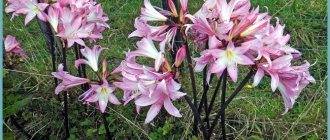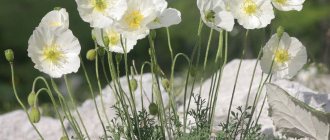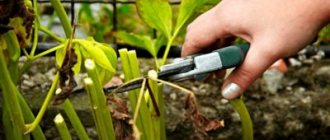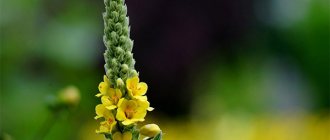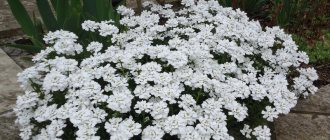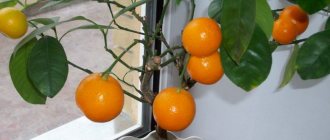What does a helenium flower look like?
Helenium is a bright decorative flower. The plant belongs to the Asteraceae genus. There are more than 30 types of heleniums, which differ in height, shape and size of flowers, and flowering time. Only 2 types of plants are popular in the CIS countries. These are picky perennials that gardeners love.
Helenium perennial.
Heleniums bloom for a long time - from one and a half months. By planting an area with several species, you can get a blooming flowerbed from June until frost. The plant tolerates heat up to 40 degrees and frost.
Yellow
Helenium yellow differs from other species in its abundant flowering. Flowers can range from golden to almost brown. At the same time, the petals are yellow and bright, but closer to the core they darken. Helenium yellow blooms in autumn. The flower is chamomile. The diameter of the inflorescence is 6 cm. The stems of the plant can reach 2 m. They break at the end.
The most popular varieties: Double Trouble, Canaria, Goldraush, Bishop.
Orange or brown
Rubinkuppel - yellow-brown flowers up to 1.5 m high.
Rubinkuppel.
Moerham Beauty - Heleniums, the flowers of which are red-brown in color. Plant height up to 80 cm.
Moerheim Beauty.
Rubincverg is a variety whose stem height is up to 50 cm. The plant loves the sun, rich in nutrients and moist soil. Blooms from June to September.
Rubinzwerg.
Two-color
Helenium bicolor is an autumn flower up to 150 cm high. The flowers are 5 cm in size. The stem is strong. The plant is often unpretentious and tolerates heat and frost well.
Rauftopaz: brown baskets. The petals are yellow at the ends, orange towards the middle. Height 1 m.
Rauchtopas.
Fursigel reaches a height of 1.2 m. The flowers are yellow-red.
Feuersiegel.
Flammenrad - yellow-orange flowers about 1 m high.
Flammenrad.
Low grades
Although most Heleniums grow 1–2 m tall, there are shorter and more compact varieties:
- Crimson beauty. Height 60 cm. Flowers orange-red.
Crimson Beauty. - Red Army is distinguished by red flowers and brown baskets. Height 60 cm. Red Army.
- Golden Jugend is a yellow flower 0.8 m high. Golden Jugend.
Planting site, soil
Caring for the plant is simple, just follow a number of rules. Mature plants grow well in any temperature regime and are able to withstand slight frosts. Young seedlings must be grown in the range of 20-22 °C above zero.
Planting by seeds
Planting perennial helenium should begin by soaking the seeds in water. It is enough to keep the seed in the liquid for 2 hours and then treat it with a solution of potassium permanganate. After completing the procedure, the seeds must be dried.
Variegated plants prefer light and airy soil with good drainage.
It is important to know! The flower does not tolerate excessive watering, flooding by rain and melt water. Due to excessive liquid, the helenium roots rot and the bush dies.
Step-by-step instructions for planting seeds:
- Soil is poured into a small container and slightly moistened.
- The seeds are distributed on the surface of the soil, without going too deep inside. It is recommended to sprinkle them with 3-4 mm of sand on top.
- The container is covered with film or glass to retain heat and speed up germination.
- Be sure to store containers in a warm and well-lit place. At first, it is necessary to moisten and ventilate the seedlings daily.
- For full development, daylight hours must be at least 65 hours.
The first shoots usually appear after a week. When the seeds have sprouted, the greenhouse can be removed, but the lighting remains at the same level. You need to wait until 3 leaves grow and then dive into different containers. After 14 days you can do the first feeding.
Transplanting
Planting in open ground and caring for helenium are the most important stages in the life of a plant. It is necessary to plant seedlings in May, when the soil has warmed up sufficiently. You must first dig small holes. The distance between them is from 40 to 80 cm, depending on the type of flower. The depth of the hole is 20 cm. It is necessary to lay drainage at the bottom, which will prevent stagnation of water in the root system of the plant. The soil is poured halfway into the hole and warm water is poured. The seedling is transferred to the hole and covered with soil in layers.
The depth of the hole must be at least 20 cm
Additional Information! Each layer must be compacted thoroughly.
When it blooms
The flowering period of helenium depends on the variety and climatic conditions and can vary from early summer to frost. Therefore, when planting, it is recommended to combine several species that bloom at different times.
Early varieties that bloom all summer
Early types of helenium include:
- Pumilum Magnificum has bright yellow flowers. Plant height is 0.6–0.8 m.
Pumilum Magnificum. - Moyerheim is a plant with copper-red, brown, lens-shaped flowers. Height 0.7–1.2 m.
Moerheim. - Vesergold - helenium 55–120 cm high. The flowers are yellow, tubular-brown, bunched.
Wesergold. - Waltrauts are perennial orange-yellow, lens-shaped flowers. Height 0.8–1 m. Waltraut.
Varieties that bloom from late July to early September
Plants with an average flowering period include the following varieties:
- Helenium autumnale is a perennial yellow tube flower, 0.6–0.9 m high. Helenium autumnale.
- Goldraush is a plant with golden yellow flowers. Height 1.4–1.5 m. Flowering period until the end of August.
Goldrausch. - Biedermeier is a helenium with red flowers with a yellow border. Height 1–1.6 m. Blooms until the end of August.
Biedermeier. - Helena - varieties ranging from yellow to dark red in color. Height 0.5–1.2 m. They begin to bloom from the first year when sown with seeds. Flowering period - until October. Helena.
- Mariachis are perennials with dense bushes. Flowering period - until the end of September.
Mariachi.
Late varieties, blooming in August and September
Few plants can boast of blooming in the fall. Among Heleniums there are such varieties. They will enhance and complement the beauty of the autumn garden.
The most famous varieties:
- Boudirector Line is a perennial plant with red tubular and lenticular flowers. Height: 1–1.2 m.
Baudirektor Linne. - Bandera is a variety with red flowers in a yellow frame. They are distinguished by their small height (40–50 cm).
Bandera. - Wild form - helenium 0.8–1.5 cm high. Inflorescences are yellow. Wildform.
How to grow helenium from seeds
Heleniums prefer open sunny areas. Plants are undemanding in care, but prefer fertile, moist soil with neutral acidity. It is best to plant flowers in a densely planted flower garden. Heleniums do not tolerate drought well, so it is important to ensure timely watering. It is better to sow seeds in containers, and then plant seedlings in open ground.
For seedlings at home
You can sow helenium seeds for seedlings in the second half of March. Prepare the soil before sowing: loosen and fertilize well. Preferred soil composition: peat and sand, or a ready-made mixture.
Sowing
Don't sow the seeds too thickly into the container. Do not save too much space so that the seedlings do not stretch out. If you have a lot of free time and enough containers for planting, sow helenium 2-3 grains in separate containers. This will greatly simplify future care and planting of seedlings in open ground. You will receive flowers much earlier, since with this method picking is not necessary. This will save the time it takes to restore plants after the procedure.
Care
Young plants require more attention than mature plants. Remember to water heleniums regularly, but do not allow moisture to stagnate. It is best to make holes in the bottom of the container in advance. This will prevent diseases and root rotting.
Place the seedlings in a well-ventilated and lit area. If there is not enough light or daylight hours are short, make additional light sources.
At the beginning of May, begin to harden the seedlings, periodically taking them out into the fresh air, into direct sunlight and wind. This will prepare the flowers for planting in open ground.
Picking
Some time after sowing, seedlings need to be pruned in densely sown areas. Diving is carried out after the appearance of 2-3 leaves. Leave about 2cm between plants.
Reproduction methods
Helenium can be propagated in one of the following ways: seeds, cuttings and dividing the bush. The easiest and most popular way is to divide the bush. The divisions are separated at the end of spring, during the transplantation period. To do this, carefully dig up the bush, separate healthy shoots and plant them in prepared holes.
Cuttings are carried out in the spring when pruning the bush. Seedlings 12 cm long are kept in a root formation stimulator for several minutes. Rooting can be carried out both in water and in a moist sandy-peat substrate. If the seedlings are planted in the ground, then for quick rooting, the cuttings are covered with a glass dome or a plastic bag. Caring for cuttings: ventilation and maintaining soil moisture. As soon as the first young leaves appear on the seedlings, this is the first sign of the beginning of rooting.
Propagation by seeds. To propagate a plant from seeds, you can use seed material collected with your own hands. The seeds begin to be collected only after the petals darken and the core of the flower turns black. The collected seeds are dried and stored in a dark place before planting.
Before starting sowing, planting material must undergo stratification. To do this, the seeds are buried in a moistened sand and peat substrate, covered with a covering material and stored for 1.5 months in a cool room, where the temperature should not be higher than 3 degrees.
At the end of winter, the container is moved to a warm, bright place. At consistently high air temperatures, seedlings appear within 2 weeks. When young seedlings form 3-4 leaves, the flower is planted in separate pots. Helenium will be ready for planting in a permanent place only after the soil has warmed up.
When is it better and how to plant seedlings in open ground?
The success of planting helenium in open ground depends on many factors: air temperature and soil humidity, the presence of sun, etc. Therefore, it is important not to make a mistake.
in autumn
It is better not to plant heleniums in the fall, unless you come across an unplanned batch of plants. The root system of seedlings is very delicate, and the first frosts occur already in early September.
If you need to plant flowers in the fall, prune the seedlings as much as possible (to a height of 10–12 cm) and be very careful with the roots. The plant has a hard time taking root. Be sure to cover young plants with organic materials for the winter.
in spring
The seedlings are quite heat-loving, so planting before May will destroy them.
Even if you harden seedlings constantly, when planting early, they need to be insulated. Only from mid-May does it become warm enough to not carry out additional manipulations. If you want to transplant heleniums earlier, insulate the soil. To do this, cover the flowerbed with dark film 1–2 weeks before the planned planting. This way the soil will warm up in the sun, which will allow the roots to strengthen faster.
If the temperature drops after planting, be sure to insulate the transplanted seedlings in the flowerbed with agrofibre or film.
Pay attention to the sun. Seedlings should be transplanted in the morning or evening on a cloudy day. If the sun does come out, shade the area with branches.
Varieties and varieties
At the moment, breeders have more than 30 varieties of perennial helenium, but the number of hybrids is not precisely recorded, since there are a lot of them. Among the existing varieties, not all are suitable for growing in open ground.
In home gardening, the following varieties of perennial helenium have proven themselves best:
- Bigelow . A medium-sized variety, reaching a height of 80 cm. In nature, it is widespread in the western regions of North America. It has entire lanceolate leaf blades. Quite large inflorescences with a diameter of about 6 cm, the outer petals of which are painted yellow and the middle part is brown, attract attention. Flowering time is June-July.
- Spring. A variety with atypical flowering times for this crop: it blooms in the second half of May. Ground shoots grow up to 1 m in height, on the upper third of which buds form. The inflorescences are orange with a brown core and can reach 7 cm in diameter.
- Gupesa. A characteristic feature is the grayish leaves, which have this color due to the thick shields covering the leaf blades. Yellow single inflorescences with petals in one row grow on long stems. The buds open at the end of June and remain on the helenium until the end of July.
- Autumn. The most widely used variety. The largest number of hybrids have been bred on its basis. It is used as an element of the second or third tier, since the height of the main shoot reaches 160 cm. The stems become woody as they grow, but remain resistant to the action of winds. Petals of a yellow or red hue border a dark yellow center. Small inflorescences 3-4 cm in size are collected in corymbs. The decorative period lasts from the beginning of September to the end of October.
Where to plant - in the sun or in the shade, soil requirements
Helenium is a sunny flower. It does well in direct sunlight. Can be planted in partial shade. But in constantly shaded areas the plant grows poorly, produces fewer flowers, and has a less beautiful appearance.
Pay attention to the condition of the soil for planting. Soil with neutral acidity is suitable for helenium. If you have a low area, first arrange drainage in the flowerbed. The root system quickly rots when water stagnates.
Heleniums grow well in loose, breathable soil. If the soil is clayey, be sure to add sand. After watering, always loosen the soil a little.
Features
Helenium, the photo of which has already attracted the attention of many people, is a herbaceous bush. It was brought from Central and North America. Now there are more than 3 dozen types of helenium, each of which is beautiful and original. The difference between herbaceous plants lies in the death in winter of not only the ground part, but also the root system.
Bud formation occurs on the underground part of the bush. This is what leads to the appearance of a new flowering stem.
With proper care, the helenium plant grows to a height of one and a half meters. The stems initially grow straight and branch at the top.
The bush grows lanceolate-shaped leaves, the arrangement of which is sequential. Single flowers bloom on the bush, the formation of which occurs in inflorescences-baskets. Their coloring is different. It can be brown, purple, orange at the edges, and yellowish in the center.
Helenium bushes grow well in areas that are well lit by sunlight. Plants grow poorly in the shade, although they produce small flower stalks.
How to plant helenium in the garden
Since heleniums are mostly tall, they are usually planted in a flowerbed in the back row. They go well with ornamental shrubs. You can plant flowers in groups or alone. They grow best next to asters, delphiniums, and dahlias, but prefer to grow next to heleniums of other varieties.
Helenium with dahlias.
How to propagate helenium
Helenium is an unpretentious plant. It can be easily grown and propagated on your own. As is the case with most perennials, you can increase the helenium plantation by seeds or vegetatively, that is, by dividing the bush and cuttings.
Dividing the bush
Division is best done in May, when the plant is actively throwing out young shoots. The bush can be divided in the fall. But in this case, the ground shoots are removed, and the plant is well covered for the entire cold period. When the rosettes of flowers have grown a little, they can be planted. To do this, dig up the entire bush. Young plants begin to separate on their own, so dividing heleniums will not be difficult.
Do not plant helenium by dividing the bush more than once every 3 years.
Transplant to a new place, just like planting seedlings. There is one important advantage. Divided bushes are hardened, so they will take root and grow faster.
Dividing the bush.
Cuttings
Helenium can also be propagated by cuttings. This is the least effective way. The cutting is separated from the adult plant. The most favorable period is spring, when the bush produces young shoots.
Place the cutting in water for 2 weeks to allow it to take root. After this, plant it in a container with special soil and cover it with film. Transplant the strengthened seedlings into the ground, having previously hardened them off.
Planting and propagation of helenium
We do not recommend growing helenium from seeds, because they have poor germination, regardless of the type and freshness of the planting material. It is better to propagate it by cuttings or by dividing the rosette.
Cuttings are the fastest and most effective way. Cuttings root directly in the soil, but you can first treat the cut with a rooting agent or fertilizer. There should be 30-35 cm between specimens, because they grow.
In spring, you can divide the tall rosettes. Just cut off the division with its roots and shoots with a sharp sterile knife, and immediately plant it separately. It is better not to do this in the fall, because young shoots will most likely die over the winter.
Photo: u-florista.ru
Outdoor care
The main thing in caring for helenium is to water and loosen the soil on time. In addition, to get a beautiful flower bed with lush, healthy plants, you need them:
- feed;
- weed;
- tie tall varieties on pegs;
- divide and replant in time;
- properly cover for the winter.
Heleniums quickly deteriorate when growing in one place, so gardeners recommend replanting and replanting the bushes every 3 years. This way they won't interfere with each other. Young plants look neater.
Pests and diseases
Helenium is rarely exposed to pests. Sometimes its leaves are affected by the chrysanthemum nematode. It is impossible to get rid of the pest. The only way is to cut off and burn all affected areas. To prevent the appearance of chrysanthemum nematodes, add a little slaked lime to the soil when planting. Also, make sure that the soil is not overly moist.
After flowering
After flowering, collect the seeds and cover the plant for the winter.
Collection and storage of seeds
The flowering of the crop ends in September. By October, the seeds ripen in the rosettes. The flower petals dry out and fall off, and seeds form in the center. They dry out and are easily removed from the socket. Store grains in gauze bags or cardboard boxes; paper envelopes are also suitable for these purposes. Store seeds in a dry, warm place. Germination persists for 2-3 years after collection.
See also
Medicinal properties and contraindications of periwinkle, use and benefits of the flowerRead
Wintering
Many types of helenium are frost-resistant. Some species and varieties do not tolerate severe frosts. At the end of the season, the shoots of the plant are cut off and the root area is mulched with moss, straw or sawdust. This will ensure the safety of the plant until the next season.
How to prepare helenium for winter
Almost all varieties of helenium need to be insulated for the winter. The plant dies from frost, so it is important to have time to prepare it for wintering before the first frost.
When to prune after flowering
Most flowering plants are pruned in late fall. But it is better to prune heleniums immediately after the faded inflorescences appear. It is not recommended to delay until frost. Heleniums do not tolerate frost well; the roots may be damaged from the stems.
How to save the root
The above-ground part of the plant is not important. In any case, when it gets colder, it will dry out. But it’s better to prevent this and cover the roots properly. To do this, you need to cut off all the above-ground parts of the plant, leaving 10 cm of stems. Then cover them with sawdust and cover them with spruce branches. In severe frosts, you can additionally cover the roots with special material from the store.
In Siberia
Although winters in Siberia are much harsher than in other parts of Russia, it is easier for heleniums to survive the winter there. And all this thanks to the thick layer of snow that will certainly fall and cover the garden. In the middle zone there may be no snow cover, which is why the ground freezes more strongly.
But it is still recommended to cut off the ground parts of helenium and mulch the soil with sawdust or moss. You can cover the plants with spruce branches on top so that there is air under the snow.
Elena Sigal
Amateur gardener, author of this blog.
Ask a Question
These are the questions that came from my readers on the topic of growing helenium.
Helenium and rudbeckia - what's the difference?
Helenium and rudbeckia are very similar in appearance. They have the same daisy-shaped flower. The height of plants can reach 2 m. The differences lie in the size of the flower. In rudbeckia they are 2–3 times larger, their color is more varied.
When is it better to replant helenium - in autumn or spring?
Heleniums are transplanted in May. They are very thermophilic, so frost after transplantation will kill the unrooted plant. Transplantation in the fall is possible only in unforeseen situations. Be sure to trim the top of the plant and protect it from the cold.
Growing and care
Helenium perennial is known to everyone as an unpretentious crop. It is often grown in places where people rarely come: country houses, summer cottages, etc. However, in order for the flower to show its full potential, some effort can be made.
The main agrotechnical measures for caring for a flower come down to applying fertilizers, weeding, watering and preparing for winter.
Watering
The basics for caring for this crop are that growth and bud formation are equally adversely affected by both drying out the soil and excessive watering. Therefore, you should carefully monitor the condition of the soil. During the summer heat, artificial watering may be required. The optimal interval between watering the soil is a week, and if perennial helenium grows in an open sunny area, then the intervals can be reduced to 3 days.
Loosening
Weeding solves two problems at once: removing weeds and improving the soil structure. Loosening the upper crust, which forms after watering, reduces water evaporation and protects the roots from drying out, while simultaneously improving the air exchange of the soil.
To simplify flower care, the surface of the earth can be mulched with a layer of peat: this will not only prevent the formation of crust, but also slow down the development of weeds.
Fertilizer
Feeding is applied three times during the growing season:
- In May-July. Add 1 tbsp of urea and potassium sulfate to a bucket of water. l. Apply the solution in a ratio of 4 liters per 1 m2.
- At the moment of active bud formation. Prepare a solution from the drug “Bud” in the amount of 1 tbsp. l. for 10 liters of water. For 1 m2 3 liters are enough. You can spray the above-ground parts of the plant with this composition.
- After flowering. Dilute 1 tbsp. l. superphosphate and 1 tbsp. l. potassium sulfate per bucket. Apply at the rate of 5 liters per 1 m2.
As flowering progresses, it is necessary to remove all dried flowers to initiate the process of formation of new buds.
Preparing for winter
After the ground organs dry out, they are cut down to soil level. This must be done so that moisture does not get through the remaining dry shoots to the renewal buds. After this, the beds are covered with a layer of mulch or lutrasil, which will protect the underground organs from freezing.
How helenium is used in landscape design - examples with photos
I made a selection of photos from the gardens of real gardeners who have helenium growing on their plot. I hope these photos will help you create a beautiful composition for your garden. You can be sure that the presence of helenium “tints” any flower garden, giving it brightness and contrast. Almost all options for proximity to helenium are unusually spectacular.
The presented composition amazes with its incredibly successful combination of colors. I can’t believe that nature itself could create such a picture!
Conifers, flowering shrubs, small architectural forms, vertical gardening - so many things are mixed in! It is the abundance of various elements of garden design that gives this landscape completeness and definition. And again helenium acts as an ornament for a picture of a blooming garden. The combination of herbaceous plants makes the flower bed look like a flowering meadow or Moorish lawn. Gelenium flowers, unusual in structure (with a convex center and petals in the shape of butterfly wings), look great with openwork decorations in the garden.
Helenium looks great both in isolated plantings and in the vicinity of other plants, be it euonymus, asters or something else. The crimson tones of autumn colors perfectly frame the flowering helenium bushes. Low-growing helenium will decorate any rockarium. The “country” style has always been and remains the most understandable and in demand in any design project. Simple red color is unobtrusive, and at the same time quite aggressive. Tall helenium bushes are quite stable, but sometimes require tying to a support.
Coniferous plants look good with heleniums, especially when the bushes are selected to be approximately the same size. Sunny colors enliven the garden in the fall, when many flowers have already finished blooming.
Soft pink pastel colors mute flashy yellow colors.
Red and white are a win-win option for creating a spectacular flower bed.
A flowerbed of pale pink, lilac-tinged, dominant dahlias is illuminated by sunspots of helenium. It’s hard to imagine a more advantageous color combination.
This flower garden combines blue and yellow colors very well. Interspersed with soft pink notes add airiness and transparency to the entire ensemble. Watercolors of blue and pink shades mute the bright yellow strokes and give the whole picture an air of sentimentality and hope.
This composition is selected taking into account contrasts: light and dark, unfolded and twisted, classic and alternative.
Helenium may well become part of the Prairie Garden, where cereals and herbaceous plants rule the roost.
Diseases and pests
Perennial helenium is characterized by persistent immunity to many diseases and insect attacks. Perhaps the only thing that can infect a plant is viral diseases, due to which the flower cannot fully grow and develop, loses its beautiful appearance, its leaves and buds become deformed. If helenium is affected by such an infection, it will have to be dug up and destroyed.
Among the pests, snails and slugs, which eat all its parts, and the chrysanthemum nematode, which attacks flowers and leaves, are considered dangerous enemies for perennial plants. In the first case, insecticides are used to control pests or wormwood, chamomile and sage are planted next to the helenium. In the second case, the affected plants are dug up and burned, and slaked lime is added to the soil.
